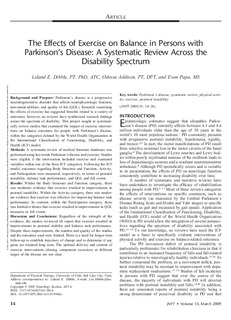| dc.identifier.citation | Dibble, L. E., Addison, O., & Papa, E. (2009). The effects of exercise on balance in persons with Parkinson's disease: a systematic review across the disability spectrum. J Neurol Phys Ther, 33(1), 14-26. | nb_NO |
| dc.description.abstract | Background and Purpose: Parkinson's disease is a progressive neurodegenerative disorder that affects neurophysiologic function, movement abilities, and quality of life (QOL). Research examining the effects of exercise has suggested benefits related to a variety of outcomes; however, no reviews have synthesized research findings across the spectrum of disability. This project sought to systematically review studies that examined the impact of exercise interventions on balance outcomes for people with Parkinson's disease, within the categories defined by the World Health Organization in the International Classification of Functioning, Disability, and Health (ICF) model.
Methods: A systematic review of medical literature databases was performed using keywords Parkinson's disease and exercise. Studies were eligible if the intervention included exercise and examined variables within one of the three ICF categories. Following the ICF model, outcomes regarding Body Structure and Function, Activity, and Participation were measured, respectively, in terms of postural instability, balance task performance, and QOL and fall events.
Results: Within the Body Structure and Function category, there was moderate evidence that exercise resulted in improvements in postural instability. Within the Activity category, there was moderate evidence that exercise was effective for improving balance task performance. In contrast, within the Participation category, there was limited evidence that exercise resulted in improvements in QOL measures or fall events.
Discussion and Conclusions: Regardless of the strength of the evidence, the studies reviewed all report that exercise resulted in improvements in postural stability and balance task performance. Despite these improvements, the number and quality of the studies and the outcomes used were limited. There is a need for longer term follow-up to establish trajectory of change and to determine if any gains are retained long term. The optimal delivery and content of exercise interventions (dosing, component exercises) at different stages of the disease are not clear. | nb_NO |
